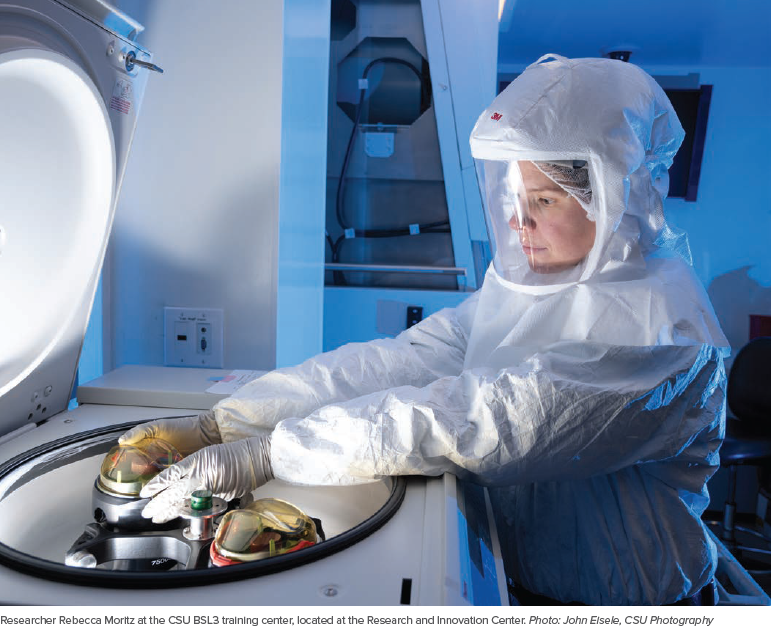The New Age of Biosecurity
By Rebecca Moritz

For all of us, the last two years have been challenging on multiple levels, both professionally and personally. As a person who has dedicated their career to conducting and supporting biological research, often focused on pathogens, preparedness, and response, the COVID-19 pandemic has been surreal. The current pandemic is vastly different from the last caused by the 2009 influenza virus. At that time, I was still conducting influenza research in laboratories specially designed for working with exotic influenza strains, in addition to safety and security duties such as training fellow researchers, writing protocols, obtaining shipping permits, and interacting with regulators. The main difference between then and now is the virus itself. There were years of influenza research at our disposal and a vaccine already existed. The response time was based on how quickly the new vaccine could be made and distributed using existing systems.
Scientists have never seen a virus quite like SARS-CoV-2 before. There are many unique attributes to this virus and the scientific, medical, and public health communities are learning more about it and the disease it causes, COVID-19, every day. It is astonishing how quickly the scientific community changed research directions to utilize their expertise and attack the problems posed by SARS-CoV-2 and COVID-19 from multiple angles. CSU has been, and remains to be, uniquely positioned to support the Colorado community as well as the world because of key research infrastructure investments that have been made over the years.
CSU has numerous laboratories specially designed to study pathogens such as SARS-CoV-2. These laboratories look the same as any ordinary laboratory from the inside. However, they are very different and highly regulated, both internally and externally, by CSU. Nothing that goes into these laboratories can come out without being decontaminated in some way. That includes the air, water, waste, and people working inside; the support systems that serve these laboratories ensure this. Then, with the procedures followed, safety equipment used, and personnel protective equipment utilized, the researchers doing the work are protected. Upon leaving these laboratories, the researchers must remove their PPE in a specific order and location on their way out. In addition, there are specialized rooms that were used for PPE for medical providers when there was a PPE shortage early in the pandemic.
CSU also has a manufacturing facility capable of making vaccines and requires a higher safety level; this lab is working on several vaccine projects related to the pandemic. Then, let us not forget about the Veterinary Diagnostic Laboratories and other CSU research laboratories that continue to support Larimer County’s and CSU’s COVID-19 testing needs.
Yet those are just the highly visible contributions that CSU has made to the pandemic. Behind those contributions is an entire safety and security infrastructure that is mostly invisible to the public. Its contributions are focused on the safety and security Program had to determine how to ensure researchers were protected from their work, as well as protected from each other while at work. We had to make sure the researchers all had the appropriate experience, training, and access to PPE.

This often meant that we were on site, ensuring the research was being done in the right type of laboratory, providing hands-of working with pathogens such as SARS-CoV-2 and all the activities described above. Researchers were not the only ones adapting; so were the safety and security, occupational health, and regulatory compliance professionals. In a brief time, we were inundated with research requests associated with a virus no one knew much about. We at CSU’s Biosafety Office and Occupational Health on-training for all aspects of working in the laboratory, and responding to incidents and emergencies, walking through procedures, and making sure all aspects were in proper order. Lastly, the Biosafety Office had to work with the various CSU compliance committees and their coordinators to ensure the required regulatory approvals for doing their specific research were in place. All of this had to be done to ensure the researchers, community, and environment were protected.
At the same time, the security of this research infrastructure and the intellectual property of CSU’s researchers requires equal thought and protections. Usually, this concept invokes the idea of “guards, gates, and guns.” While physical security is incredibly important and critical to the research enterprise, so is the protection of novel technology and research data, i.e., bio-cybersecurity. Countries and companies around the world were clamoring to be the first to successfully create effective vaccines and treatments to prevent and treat COVID-19 to protect their citizens and political interests.

There were multiple cyberattacks attempting to obtain technology and research data from companies and research institutions involved in developing vaccines and treatments. There were also cyberattacks aimed at disrupting vaccine production and distribution pipelines. Even before the pandemic, CSU recognized the importance of teaching students about bio-cybersecurity and gave them hands-on experience through weekend-long hackathon challenges, one of which is scheduled for this spring. Our unique assets in the biosecurity arena position us to train the next-generation workforce needed to thwart these attacks. We will continue to seek ways to integrate biosecurity into our cyber and data sciences curriculum.
This pandemic is a sobering reminder of how important it is to have a nimble research infrastructure protected from physical and virtual threats. Unfortunately, SARS-CoV-2 is not the last emerging pathogen. There are many more on the horizon; some already threatening humans, animals, agriculture, and food supplies. CSU’s research enterprise will always be a wealth of valuable technology and research data. CSU will continue to be a leader in pandemic preparedness and response by working to minimize the effects these pathogens have locally and worldwide. While doing so, the CSU research enterprise will continue to invest in and support the infrastructure needed to ensure this research is conducted in the safest and most secure manner possible, while also protecting its research enterprise and intellectual property and creating a strong bio-cybersecurity workforce.